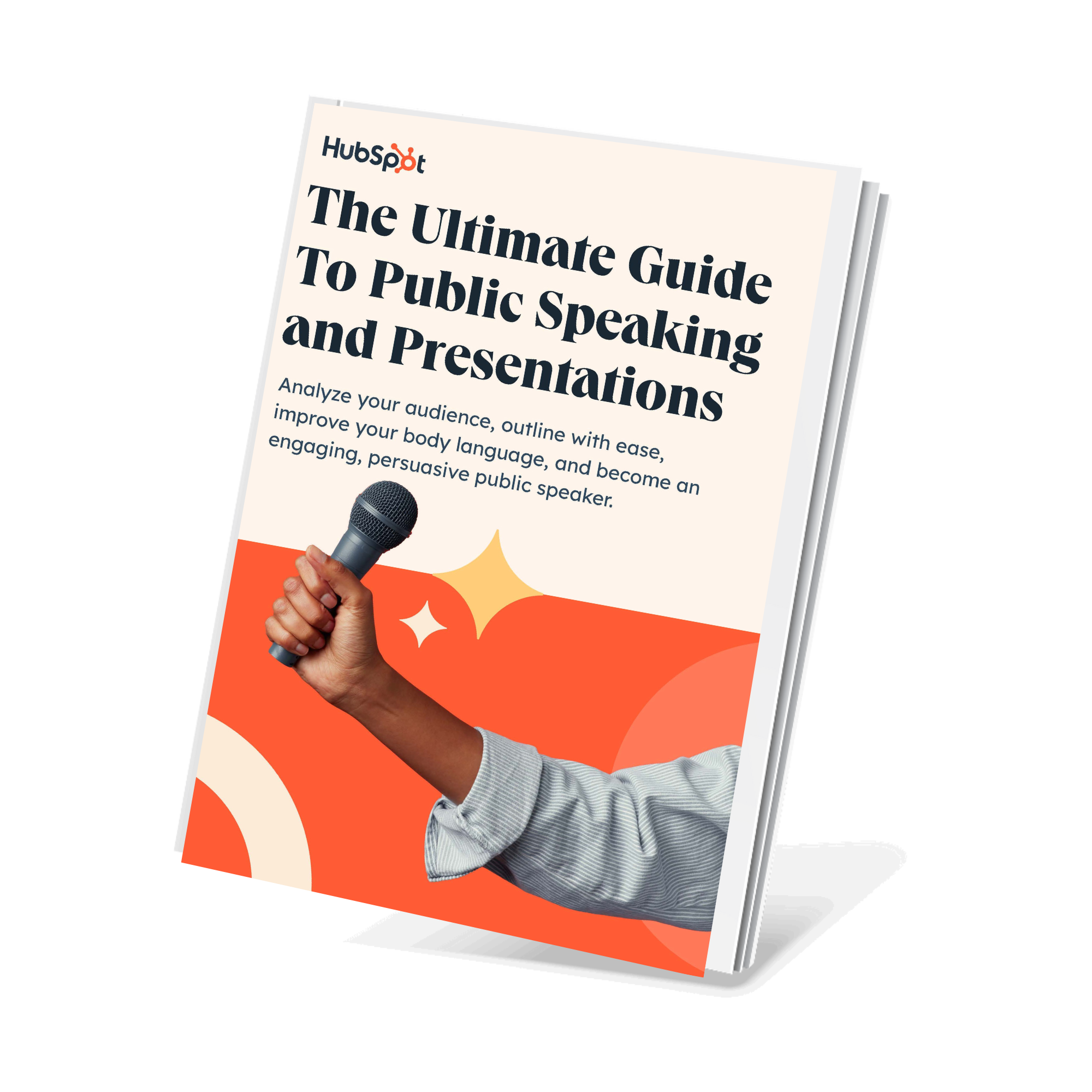What is a persuasive presentation?
In its most basic form, a persuasive presentation features a speaker who tries to influence an audience to accept certain positions and engage in actions in support of them. A good persuasive presentation uses a mixture of facts, logic, and empathy to help an audience see an issue from a perspective they previously discounted or hadn’t considered.
How to Plan a Persuasive Presentation
Want to make a persuasive presentation that connects with your audience? Follow these steps to win friends and influence people within your audience.
1. Decide on a single ask.
The key to convincing your audience is to first identify the singular point you want to make. A good persuasive presentation will focus on one specific and easy-to-understand proposition. Even if that point is part of a broader initiative, it ideally needs to be presented as something your audience can say "yes" or "no" to easily.
A message that isn’t well-defined or which covers too much can cause the audience to lose interest or reject it outright. A more focused topic can also help your delivery sound more confident, which (for better or worse) is an important factor in convincing people.
2. Focus on fewer (but more relevant) facts.
Remember: You are (in the vast majority of cases) not the target audience for your presentation. To make your presentation a success, you’ll need to know who your audience is so you can shape your message to resonate with them.
When crafting your messaging, put yourself in your audience's headspace and attempt to deeply understand their position, needs, and concerns. Focus on arguments and facts that speak specifically to your audience's unique position.
What are the target audience's pain points that you can use to make a connection between their needs and your goals? Focus on those aspects, and cut any excess information. Fewer relevant facts are always more impactful than an abundance of unfocused pieces of evidence.
3. Build a narrative around your evidence.
If you want to persuade someone of something, it’s not enough to win their brain -- you need their heart in it, too. Try to make an emotional connection with your audience throughout your presentation to better sell them on the facts you’re presenting. Your audience is human, after all, so some emotional tug will go a long way to shaking up how they view the issue you’re talking about. A little bit of emotion could be just what your audience needs to make your facts “click.”
The easiest way to incorporate an emotional pull into your presentation is through the use of narrative elements. As we wrote in our guide to crafting pitch decks, "When our brains are given a story instead of a list of information, things change -- big time. Stories engage more parts of our brains, including our sensory cortex, which is responsible for processing visual, auditory, and tactile stimuli. If you want to keep people engaged during a presentation, tell them a story."
4. Confidence matters.
Practice makes perfect (it's a cliche because it's true, sorry!), and this is especially true for presentation delivery. Rehearse your presentation several times before you give it to your audience so you can develop a natural flow and move from each section without stopping.
Remember, you're not giving a speech here, so you don't want your delivery to come across like you're reading fully off of cue cards. Use tools like notes and cue cards as ways to keep you on track, not as scripts.
Finally, if you can, try to practice your presentation in front of another human. Getting a trusted co-worker to give you feedback in advance can help strengthen your delivery and identify areas you might need to change or bulk up.
5. Prepare for common objections.
The last thing you want to say when someone in your audience expresses a concern or an outright objection during your presentation's question section is “umm, let me get back to you on that.”
Carefully research the subject of your presentation to make the best case possible for it -- but also prepare in advance for common objections or questions you know your stakeholders are going to ask. The stronger your command of the facts -- and the more prepared you are to proactively address concerns -- the more convincing your presentation will be. When you appear confident fielding any rebuttals during a question and answer session after your presentation, it can go a long way towards making your case seem more convincing.
Persuasive Presentation Outline
Like any writing project, you’ll want to create an outline for your presentation, which can act as both a prompt and a framework. With an outline, you’ll have an easier time organizing your thoughts and creating the actual content you will present. While you can adjust the outline to your needs, your presentation will most likely follow this basic framework.
I. Introduction
Every persuasive presentation needs an introduction that gets the listener’s attention, identifies a problem, and relates it to them.
- The Hook: Just like a catchy song, your presentation needs a good hook to draw the listener in. Think of an unusual fact, anecdote, or framing that can grab the listener’s attention. Choose something that also establishes your credibility on the issue.
- The Tie: Tie your hook back to your audience to garner buy-in from your audience, as this issue impacts them personally.
- The Thesis: This is where you state the position to which you are trying to persuade your audience and forms the focal point for your presentation.
II. The Body
The body forms the bulk of your presentation and can be roughly divided into two parts. In the first half, you will build your case, and in the second you will address potential rebuttals.
- Your Case: This is where you will present supporting points for your argument and the evidence you’ve gathered through research. This will likely have several different subsections in which you present the relevant evidence for each supporting point.
- Rebuttals: Consider potential rebuttals to your case and address them individually with supporting evidence for your counterarguments.
- Benefits: Outline the benefits of the audience adopting your position. Use smooth, conversational transitions to get to these.
- Drawbacks: Outline what drawbacks of the audience rejecting your position. Be sure to remain conversational and avoid alarmism.
III. Conclusion
In your conclusion, you will wrap up your argument, summarize your key points, and relate them back to the decisions your audience makes.
- Transition: Write a transition that emphasizes the key point you are trying to make.
- Summary: Summarize your arguments, their benefits, and the key pieces of evidence supporting your position.
- Tie-back: Tie back your summary to the actions of your audience and how their decisions will impact the subject of your presentation.
- Final word: Try to end on a last emotional thought that can inspire your audience to adopt your position and act in support of it.
IV. Citations
Include a section at the end of your presentation with citations for your sources. This will make independent fact-checking easier for your audience and will make your overall presentation more persuasive.
Persuasive Presentation Examples
Check out some of these examples of persuasive presentations to get inspiration for your own. Seeing how someone else made their presentation could help you create one that strikes home with your audience. While the structure of your presentation is entirely up to you, here are some outlines that are typically used for different subjects.
Introducing a Concept
One common type of persuasive presentation is one that introduces a new concept to an audience and tries to get them to accept it. This presentation introduces audience members to the dangers of secondhand smoke and encourages them to take steps to avoid it. Persuasive presentations can also be a good format to introduce marco issues, such as this presentation on the benefits of renewable energy.
Changing Personal Habits
Want to change the personal habits of your audience? Check out this presentation on how to adopt healthy eating habits. Or this presentation which encourages the audience to get more exercise in their daily lives.
Making a Commitment to an Action
Is your goal to get your audience to commit to a specific action? This presentation encouraging audience memes to become organ donors could provide inspiration. Trying to make a big sale? Check out this presentation outline that can encourage someone to buy a home.
Remember: You Can Do This
Anyone can craft a persuasive presentation once they know the basic framework for creating one. Once you get the process down, you’ll be in a better position to bring in sales, attract donors or funding, and even advance your career. The skills you learn can also benefit you in other areas of your personal and professional life as you know how to make a case and influence people toward it.
Presentations



![PowerPoint Tips to Present Like a Pro [Expert Advice & Free Templates]](https://53.fs1.hubspotusercontent-na1.net/hubfs/53/powerpoint-design-tricks_7.webp)

![20 Great Examples of PowerPoint Presentation Design [+ Templates]](https://53.fs1.hubspotusercontent-na1.net/hubfs/53/powerpoint-presentation-examples.webp)
![How to Create the Best PowerPoint Presentations [Examples & Templates]](https://53.fs1.hubspotusercontent-na1.net/hubfs/53/powerpoint.webp)



![How to Start a Presentation [+ Examples]](https://53.fs1.hubspotusercontent-na1.net/hubfs/53/how-to-start-presenting.webp)

